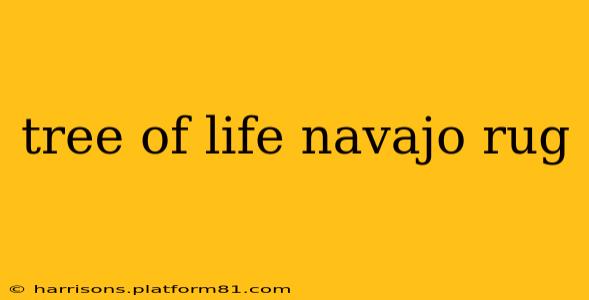The Navajo Tree of Life rug is more than just a beautiful piece of textile art; it's a powerful symbol steeped in rich cultural heritage and spiritual significance. These rugs, renowned for their intricate designs and vibrant colors, tell stories of life, growth, and connection to the natural world. Understanding their symbolism provides a deeper appreciation for the artistry and cultural legacy behind them. This guide will delve into the meaning of the Tree of Life motif in Navajo weaving, exploring its historical context and the elements that contribute to its profound significance.
What Does the Tree of Life Symbolize in Navajo Culture?
The Tree of Life, often depicted centrally within a Navajo rug, symbolizes the interconnectedness of all living things. Its roots reach deep into the earth, representing the ancestors and the past, while its branches stretch towards the sky, embodying the future and the spiritual realm. The trunk, strong and steady, symbolizes the present moment and the enduring strength of the Navajo people. This visual representation captures the cyclical nature of life and the continuous flow of energy between generations.
What are the Different Elements Depicted in a Navajo Tree of Life Rug?
Beyond the central tree, other elements contribute to the overall narrative and symbolism. These can include:
- Mountains: Representing strength, stability, and connection to the earth.
- Water: Symbolizing life, purity, and renewal. Often depicted as flowing streams or a placid lake.
- Animals: Depicting the balance of nature and the interconnectedness of the ecosystem. Common animals include sheep, horses, and birds, each carrying its own symbolic weight within Navajo culture.
- Geometric patterns: These often represent the Navajo clans or specific family histories, adding another layer of personal significance to the rug.
These elements, woven together in a harmonious composition, create a visual tapestry that speaks volumes about Navajo cosmology and worldview.
How Can I Tell if a Navajo Rug is Authentic?
Determining the authenticity of a Navajo rug requires careful examination. Several factors contribute to its verification:
- Weaving techniques: Traditional Navajo rugs are hand-woven using specific techniques passed down through generations. The quality of the weave, the evenness of the yarns, and the overall craftsmanship can indicate authenticity.
- Dyeing methods: Traditionally, natural dyes were used, resulting in subtle variations in color and a certain depth of tone not easily replicated.
- Materials: Authentic Navajo rugs are typically made from natural fibers like wool, often hand-spun.
- Designs: While variations exist, certain design elements and stylistic choices are indicative of particular periods or weaving traditions. Expertise in Navajo rug design is vital for confident identification.
What Makes a Navajo Tree of Life Rug Unique and Valuable?
The uniqueness of each Navajo Tree of Life rug stems from the individual artistry and the stories embedded within its design. No two rugs are exactly alike; each one reflects the weaver's skill, personal experiences, and cultural heritage. This individuality, combined with the enduring symbolism of the Tree of Life motif, contributes to the considerable value these rugs hold as both art and cultural artifacts.
Where Can I Find More Information About Navajo Rugs?
To delve deeper into the rich history and symbolism of Navajo rugs, exploring resources from reputable museums and Navajo cultural institutions is recommended. These provide accurate and respectful information, contributing to a greater understanding and appreciation for this remarkable art form.
This comprehensive guide provides a detailed look at the compelling symbolism and craftsmanship behind Navajo Tree of Life rugs. Understanding the cultural significance enhances the appreciation for these stunning works of art, showcasing the enduring creativity and spiritual depth of the Navajo people.
